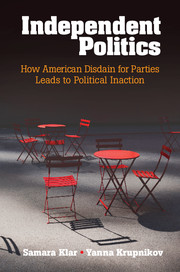Book contents
- Frontmatter
- Contents
- List of Figures
- List of Tables
- Acknowledgments
- 1 Independents in Name Only
- 2 Inside the Mind of an Independent Voter in America
- 3 How Do You Like Me Now? The Desirability of Political Independence
- 4 Everybody Hates Partisans
- 5 Partisanship and Political Participation
- 6 Undercover Partisans in America
- 7 The Myth of Partisan Compromise
- 8 The Partisan Underground in an Era of Polarization
- Appendix
- References
- Index
7 - The Myth of Partisan Compromise
Published online by Cambridge University Press: 05 January 2016
- Frontmatter
- Contents
- List of Figures
- List of Tables
- Acknowledgments
- 1 Independents in Name Only
- 2 Inside the Mind of an Independent Voter in America
- 3 How Do You Like Me Now? The Desirability of Political Independence
- 4 Everybody Hates Partisans
- 5 Partisanship and Political Participation
- 6 Undercover Partisans in America
- 7 The Myth of Partisan Compromise
- 8 The Partisan Underground in an Era of Polarization
- Appendix
- References
- Index
Summary
“Bipartisanship is not the opposite of principle. One can be very conservative or very liberal and still have a bipartisan mindset.”
– Richard Lugar, Republican Senator, Indiana, concession statementConsider these two facts: (1) nearly 40 percent of Americans identify as political independents; (2) 58 percent of Americans believe that America needs a third party. The conditions seem perfect for a third party to emerge onto the American political scene. At the very least, one might expect that Democrats and Republicans should embrace bipartisanship in hopes of appealing to so many disaffected Americans.
Yet in reality, the reverse is happening. Alternatives to the Republican and Democratic parties have declined dramatically over the past century (Tamas and Hindman 2014), as has voter support for third and minor parties (Hirano and Snyder 2007). Meanwhile, Democratic and Republican candidates are increasingly ideologically extreme (Großer and Palfrey 2014) and the American public often appears increasingly partisan, especially in their affect toward members of the opposing party (Iyengar et al. 2012; Mason 2014).
How is it possible that an electorate in which nearly a plurality of people claim they are independent exists in this political climate? One of the greatest divides in American politics may well be the chasm between what we say and what we do.
Throughout this book, we have shown the degree to which negative perceptions of partisanship influence the way ordinary Americans relate to politics. From self-identifying as independent to withdrawing from political conversation, eschewing outwardly partisan forms of political participation, and avoiding partisan coworkers and neighbors, many Americans are going undercover and deliberately avoiding partisanship. Throughout these chapters, however, we have not addressed the elephant in the room. How is it that Americans are both anti-partisan and politically polarized?
In this chapter, we examine whether the people who reject partisanship are distinct from those who are polarized. Although undercover partisans may not actually be “independent” in the political sense of the word, perhaps they are so ashamed of parties that they have begun to seek compromise and hold their representatives accountable to bipartisan values. We explore what undercover partisans want from parties in two ways. First, we take people at their own word and we simply ask people who call themselves “independent” to tell us what they want from politics and from their representatives.
- Type
- Chapter
- Information
- Independent PoliticsHow American Disdain for Parties Leads to Political Inaction, pp. 127 - 149Publisher: Cambridge University PressPrint publication year: 2016

